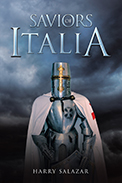
 |
The Roman Empire has fallen, and Christianity is not as prevalent as it once was in the city-states of Italia. Leaders alike are falling prey to the influence of evil and Satan, and the people are suffering. Yet there is hope—a prophecy foretold in Torrance, Umbria speaks of a war between the forces of good and evil and the triumphant return of Christianity. But before the forces of evil can be vanquished, however, a true leader must be found.
Set in early medieval times after the 6th century, this story blends religion, adventure, history, fantasy, and politics together to build an intriguing, alternate history that heralds the return of Christianity to “Italia.” Like most fantasy novels, the author lays down the historical foundations of the story before diving into the present day. He takes his time to build out the characters and their problems before intertwining each part of the story. The result is strong worldbuilding, a fleshed-out cast of characters, and a layered, generation-spanning story.
One element that complements the story is the narrator’s prose. Simplistic at times, it has a natural speech cadence, similar to that of an oral storyteller, which gives the reader the sense he is actually listening to the story being told. Due to the religious tones and themes found within the book, there are times when the dialogue may come across as a bit preachy. Aside from this, though, the story flows nicely. Since the novel ends with the appointment and training of the knights, it seems that there may be a sequel to complete the story.